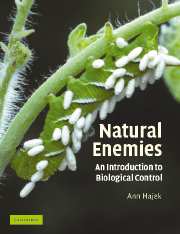Book contents
- Frontmatter
- Contents
- Preface
- Acknowledgments
- Introduction
- PART I Strategies for using natural enemies
- PART II Biological control of invertebrate and vertebrate pests
- Chapter 6 Ecological basis for use of predators, parasitoids, and pathogens
- Chapter 7 Predators
- Chapter 8 Insect parasitoids: attack by aliens
- Chapter 9 Parasitic nematodes
- Chapter 10 Bacterial pathogens of invertebrates
- Chapter 11 Viral pathogens
- Chapter 12 Fungi and microsporidia
- PART III Biological control of weeds
- PART IV Biological control of plant pathogens and plant parasitic nematodes
- PART V Biological control: concerns, changes, and challenges
- Glossary
- References
- Index
Chapter 8 - Insect parasitoids: attack by aliens
Published online by Cambridge University Press: 05 June 2012
- Frontmatter
- Contents
- Preface
- Acknowledgments
- Introduction
- PART I Strategies for using natural enemies
- PART II Biological control of invertebrate and vertebrate pests
- Chapter 6 Ecological basis for use of predators, parasitoids, and pathogens
- Chapter 7 Predators
- Chapter 8 Insect parasitoids: attack by aliens
- Chapter 9 Parasitic nematodes
- Chapter 10 Bacterial pathogens of invertebrates
- Chapter 11 Viral pathogens
- Chapter 12 Fungi and microsporidia
- PART III Biological control of weeds
- PART IV Biological control of plant pathogens and plant parasitic nematodes
- PART V Biological control: concerns, changes, and challenges
- Glossary
- References
- Index
Summary
In the 1979 movie Alien, starring Sigourney Weaver, a crew member traveling through space with Weaver becomes infested with an alien life-form. The alien develops within the crew member until almost the crew member's size and then emerges dramatically from the crew member's chest, killing him as it emerges. This screenplay could have been written by a parasitoid biologist. While the aliens are portrayed as bad and scary in the movie, in nature, parasitoids of insect hosts are part of complex food webs and their use in regulation of insect pest populations is a cornerstone of biological control.
Parasitoids are therefore a second major type of natural enemy used to control invertebrates. Parasitoid is a term derived from the more general term parasite. Parasites are organisms living in or on other organisms, from which they gain nourishment. The term parasitoid specifically refers to insects that parasitize other insects when they are immature but are free-living when adult. Parasitoids can be distinguished within the larger category of parasites because they eventually kill their host after completing development and use only a single host. In contrast, predators usually consume several hosts (prey) to develop. Many parasitoids have a holometabolous life style that allows the different life stages of parasitoids to specialize in different ways at different ages. Immature parasitoids are often soft-bodied, grub-like or maggot-like in form, and remain in close association with hosts to maximize their growth and development. The immatures feed on hosts either externally or internally and usually have no legs or eyes.
- Type
- Chapter
- Information
- Natural EnemiesAn Introduction to Biological Control, pp. 145 - 169Publisher: Cambridge University PressPrint publication year: 2004
- 1
- Cited by



